
Nammo ramjet artillery round: a game changer?
Eurosatory marked the unveiling the mock-up of what might become a game-changer in the field artillery world: a 155 mm round in development by Nammo which propulsion goes well beyond what has been available since now. It is not the first time that a company decides to add jet propulsion to artillery rounds, Somchem in South Africa and Poongsan in South Korea being among the latest companies that announced developments in that field. In fact the future Nammo round might be considered a weaponised ramjet, as design parameters have to adhere strictly to the aerodynamics of the simplest form of jet propulsion system, which features no moving parts the compressor being replaced by the sheer air speed of the system. This is given by the velocity of the round when it leaves the barrel, which for a 155 mm ammunition fired from a 155/52 mm artillery system is around Mach 3, well enough to ensure the right conditions to make the engine working. Two main range extension technologies are currently used.
The base bleed does not add any thrust, the grains burning for 35-50 seconds simply reducing the drag, thus increasing the range from 30 to 40 km in 52 calibre systems. RAP, for rocket assisted propulsion, adds a limited thrust while zeroing the drag, but just for a few seconds, and at the cost of nearly half the explosive payload, range extension more than doubling the original 30 km one, accuracy being however considerably reduced. The technology chosen by Nammo, dubbed ExR for extreme range, will bring the range in the three-digit dimension, the Mach 3 velocity being maintained for around 50 seconds, a ramjet being inherently self-regulating maintaining a constant Mach number independently of altitude, allowing the round to hit a target at over 100 km; this means that one single artillery system will be able to cover an area of over 31,000 km2 compared to the 5,000 km2 covered by a current 155/52 mm artillery tube with extended range rounds. Accuracy will definitely be reduced, Nammo considers the CEP being 10 times that of an ER round, thus the Norwegian company is carrying on two parallel programmes, one for extending the range, the second for providing the round with a guidance system. Considering the stringent aerodynamic requirements no sensor can be installed in the nose, thus a GPS/INS solution is being considered, this part of the programme being developed with a partner company.

Nammo is concentrating on the development of the solid fuel ramjet, the solid hydrocarbon fuel used being hydroxyl-terminated polybutadiene (HTPB) with additives, exploiting its testing facilities. Currently a series of activities are ongoing, such as combustor tests and performances evaluation, the development of the high-performance air intake, and the implementation of high performing sub-systems components. An advanced fly-out simulator allows to study ballistic flight trajectories, with a guided 6-degrees of freedom round. The round is being designed to be fully compatible with the JBMOU L52 155, in order to allow it to be fired by any current system developed in accordance with that standard. The presence of the ramjet inevitably reduces the amount of explosive, Nammo declaring an amount of “HE explosive with similar weight as 120 mm round”, which should mean between 3 and 3.5 kg. The warhead will be designed to neutralise soft targets, such as light armoured vehicles, radars, ground-based air defence systems, thus an HE-FRAG solution is foreseen, while no anti-armour effect is being considered. Nammo’s 155 mm ExR is expected to have its first ballistic flight test in 2019/2020, probably without guidance, the company looking forward to have it operational in 2023-2024.
In parallel Nammo is exploiting the research on the solid fuel ramjet to develop a supersonic missile with a propulsion time of over 100 seconds; according to the few information released, it should have a diameter around 250 mm and be used in ground-to-air missions at low altitude. A first demonstration is planned in 2021.


